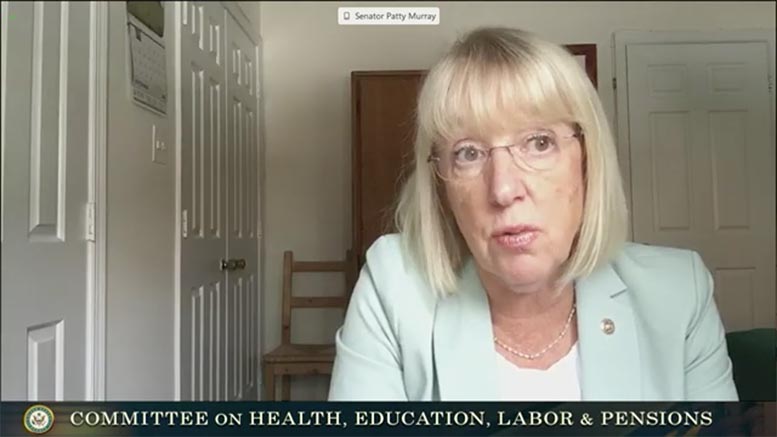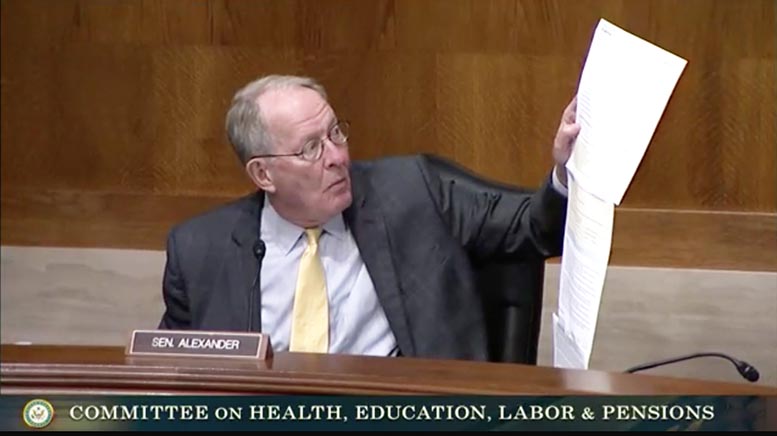It is unlikely Congress will reauthorize the Higher Education Act this year, but the departing chair of the Senate’s education committee hopes to at least complete by year’s end a long goal of his: to make it easier for college students to apply for federal student aid.
Sen. Lamar Alexander (R-Tennessee), who is not running for re-election and on Thursday held what may be his last education hearing with the Senate Health, Education, Labor and Pensions Committee, aims to finish his years-long effort to simplify the Free Application for Federal Student Aid (FAFSA) and streamline the application process. Although Congress, two administrations and the U.S. Education Department have over the last several years made changes to the FAFSA – from decreasing the number of questions on the form, to developing an app for it – more can be done to encourage students to apply, he said.
It’s especially important during the pandemic, which has upended the lives of many college students and prospective students, Alexander said. Too often, students don’t even apply because of the length of the form or they are held up because of administrative processes, such as the federal government’s requirement that selected applicants verify information on the FAFSA – essentially asking them to submit the same information twice.
In addition, a growing number of families are questioning whether they can afford a higher education or if the current remote format used at most colleges is worth the cost, the senator said.
“Many of the low-income students who would benefit most economically from college long term are putting it off altogether,” Alexander said.
Weariness over completing the FAFSA has cascading effects, as many other types of aid are based on the application, from state aid to scholarships, Alexander said. He noted former Tennessee Gov. Bill Haslam told him the biggest barrier to offering aid to community college students through the popular Tennessee Promise program has been getting students to complete the FAFSA.
“After nearly seven years of work on these issues, it all boils down to this: it makes no sense to make it this complicated to apply for federal aid for college,” Alexander said. “It makes no sense to discourage the very students Congress wants to encourage to attend college and benefit from federal financial aid.”
A final push
At Thursday’s hearing, Alexander reiterated several goals for FAFSA reform and had some additions. He said he wants to significantly lower the number of questions on the FAFSA (from 108 to no more than 33), develop better coordination between the Education Department and IRS for student information, and continue to revamp the cumbersome verification process.
Alexander also said he wants to make it easier for homeless students, foster care students and students not living with their parents to apply for and receive student aid. He added that he would like to see a simple Pell Grant eligibility chart so that middle and high school students can estimate how much Pell Grant money they could receive for college.
With the changes, an additional 420,000 students would qualify for Pell grants each year, according to the Congressional Budget Office. And an additional 1.6 million students would qualify to receive the maximum Pell award each year, Alexander said.

The changes appear to have support from key Democrats, including Ranking Member Patty Murray (D-Washington), who noted at the hearing that the effects of the pandemic are hitting hard those students who already struggle with accessing information about student aid, counseling, dependable technology and more.
Murray also encouraged lawmakers to pass another coronavirus-related relief package that will help colleges and students during the pandemic. There are already more than 88,000 cases of coronavirus on college campuses and 60 deaths, she said.
Positive changes, challenges
The changes made over the past few years to the FAFSA have yielded results, according to a panel of student aid experts at the hearing on Thursday. For example, using so-called “prior-prior year” tax information, which better aligns with when students make decisions on colleges, and the launch of a mobile FAFSA app helped to increase by 9 percent the number of FAFSA applications from high school seniors the following year, said Kim Cook, executive director of the National College Attainment Network.
Using prior-prior year tax information also helped to increase the number of FAFSA applicants who are Pell-eligible by 50,000, she said.
“Clearly, simplification matters,” she said.
However, the FUTURE Act passed in December that included changes to FAFSA won’t be fully implemented until the 2023-24 FAFSA cycle due to data security and other technical issues, Cook said. That caught the attention of some lawmakers, including Sen. Doug Jones (D-Alabama), who asked how the revamped FAFSA could be implemented sooner.
Part of the issue is linking data from the Education Department (ED) and IRS systems, said Kristin Hultquist, a founding partner at HCM Strategists and a former ED official.
“The current law uses data elements from tax forms that no longer exist” due to newer tax reform laws, Hultquist said. ED is currently using a different tax form to get the needed information, but that form is not recognized under the FUTURE Act, she said. Tweaks to the legislation would likely help to implement the changes more smoothly, she added.
Cascading effects
Regarding the proposed Pell Grant early awareness chart, Sen. Lisa Murkowski (R-Alaska) asked if that could potentially mislead some students and families on how much aid they could get, noting that it would be based on their current income, which could change by the time they are ready for college.
Judith Scott-Clayton, associate professor of economics and education in the Teachers College at Columbia University in New York, said that is a minor concern that is outweighed by students not even applying.
“I’m way more worried about students not preparing for college because they think they won’t qualify,” she said.
Some research at Harvard University indicates that such information can inspire not only college students but also younger family members, said Bridget Terry Long, dean and professor of education and economics at the Harvard Graduate School of Education in Massachusetts. A pre-estimate of potential financial aid shared with high school students and their younger siblings found that it inspired families to meet with counselors and others to start a conversation about student aid, she said.
“It grabbed their attention so that they were coming in to get the advising, not just about financial aid, but about college choice and program of study, which is also a very important part of the process,” Long said.
Murray also asked the panel members whether changes to the FAFSA could help connect students with other services for which they could be eligible, such as federal SNAP and TANF benefits.
“Since it is tied to the federal poverty level, it could get us to crosswalk other means-tested benefits programs that are also tied to the federal poverty level,” Cook said.
She added there are opportunities to flag eligible students during loan counseling and share such information with them.

